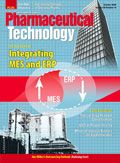Integration the Easy Way
Pharmaceutical companies want software vendors to make integrating manufacturing execution systems and enterprise resource planning systems easier.
Software vendors argue that integrating manufacturing execution systems (MES) and enterprise resource planning (ERP) systems is a less daunting project now because the technology has advanced and users have become more sophisticated. "It's not a miracle anymore," says Rolf Blumenthal, senior director of international consulting at Werum Software and Systems (Lüneburg, Lower Saxony, Germany). For the most part, pharmaceutical companies that use the software generally agree.
Still, some manufacturers wish the task were easier. Integrating these two systems "is still a lot of work" and "a custom job for each customer," says Herschel Kenney, senior director for information-technology (IT) planning and resource management at Purdue Pharma (Stamford, CT).
A plug-and-play solution. Kenney and other users want a plug-and-play ability to integrate different software packages. The vendors are beginning to tackle this problem. SAP (Newtown Square, PA) seeks to provide solutions that enable integration so its manufacturing customers can harmonize their shop-floor and enterprise levels, according to Jim Sabogal, vice-president of industry solutions for life sciences at the company.
SAP and Werum have collaborated to simplify the integration of their products, and the companies say this strategy will continue. Werum's "PASECMI" solution is a result of the collaboration with SAP. The solution combines a fixed selection of modules that support well defined business processes in the weighing and dispensing area. It provides out-of-the-box integration with SAP, Bluementhal says.
SAP, Werum, and Tata Consultancy Services jointly built a Perfect Plant Center of Excellence at SAP's headquarters. The center allows pharmaceutical customers to experience the companies' integration solutions firsthand before adopting them.
Microsoft (Redmond, WA), too, collaborates with MES vendors such as Aspentech, Emerson, and Siemens, adds Ruediger Dorn, the company's managing director of the pharmaceutical industry.
Less maintenance. Users would also like to see MESes, ERP systems, and interfaces that require little maintenance. For example, updates should be required less frequently, and should not involve extensive retesting of functionality, Kenney says. Systems should also archive data efficiently and let users perform backup while the systems are running.
When a pharmaceutical company performs IT maintenance, it must submit change-control, risk-analysis, and technical-assessment documents for regulatory approval. Designing MES software according to good software engineering practices and following software-development life cycle practices would reduce maintenance requirements, says José Matos, manufacturing-systems and process automation manager at Bristol-Myers Squibb (New York).
The fact that integration still involves writing custom code means that system upgrades require new coding and extensive testing, observes Govi Sridharan, senior automation engineer at Genentech (San Francisco, CA). A plug-and-play integration solution could reduce maintenance.
Low cost. Reducing the cost of integration is another user demand. If vendors follow good software engineering practices and open architectural systems standards, it will minimize the cost of ERP–MES commissioning and validation, according to Matos. Applications that follow the service-oriented architecture design can help lower intergration costs, Kenney says, as would plug-and-play (rather than custom) integration.
B2MML compliance. Sridharan would also like to see MES and ERP systems send and receive data in a standard, Business to Manufacturing Markup Language (B2MML)-compliant format. Nonstandard formats require companies to write and validate custom code to exchange data between systems. Using the B2MML-compliant format would "drastically reduce" the cost of integration because "the integration layer just becomes a transportation layer without any modification of data," Sridharan explains.
Quality-assurance capabilities. Companies also express interest in using MES to share quality-assurance (QA) responsibilities among manufacturing sites. Being able to allow a central team to perform QA checks of products made at another plant and, conceivably, initiate corrective action remotely is a distinct advantage, Kenney says. This arrangement could promote best practices and complete investigations quickly. Users would like to achieve this functionality without the need for expensive custom integration.
Regulatory capabilities. Companies already use MES to review batch records by exception. Integrating MES with an ERP system allows events to be managed and recorded online. Once a firm had this capability, it could create a batch-record review center of excellence to examine data from multiple global sites. The center of excellence could save time because the global reviewers would become proficient. It would also save money because best practices would naturally be disseminated throughout the global organization, says Kenney.
"To the extent that that batch-record review occurs online, it doesn't matter where the reviewer sits," Kenney says. Centralized review and online reporting to regulators could improve the speed and quality of reviews and allow a company to optimize its record-review function, Kenney adds.
For more on this topic, see Putting Together the Pieces

Drug Solutions Podcast: A Closer Look at mRNA in Oncology and Vaccines
April 30th 2024In this episode fo the Drug Solutions Podcast, etherna’s vice-president of Technology and Innovation, Stefaan De Koker, discusses the merits and challenges of using mRNA as the foundation for therapeutics in oncology as well as for vaccines.
Pharmaceutical Tariffs Are Imminent: How Industry is Bracing for Impact
April 16th 2025On April 14, 2025, the Trump Administration launched a national security-driven investigation into pharmaceuticals, a move that will likely result in tariffs being placed on pharmaceutical drugs, ingredients, and other components that are imported from outside of the United States.